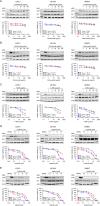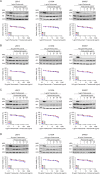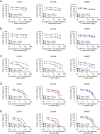Combined targeting of HER-2 and HER-3 represents a promising therapeutic strategy in colorectal cancer
- PMID: 31488078
- PMCID: PMC6727342
- DOI: 10.1186/s12885-019-6051-0
Combined targeting of HER-2 and HER-3 represents a promising therapeutic strategy in colorectal cancer
Abstract
Background: Abrogation of growth factor-dependent signaling represents an effective therapeutic strategy for patients with colorectal cancer (CRC). Here we evaluated the effectiveness of targeting the epidermal growth factor (EGF) receptors HER-2 and HER-3 in the three cell lines LS513, LS1034 and SW837.
Methods: Treatment with HER-2-specific antibodies trastuzumab and pertuzumab resulted in a mild reduction of cellular viability. In contrast, the antibody-drug conjugate T-DM1 mediated a strong and dose-dependent decrease of viability and Akt phosphorylation.
Results: The most striking effects were observed with the dual tyrosine kinase inhibitor lapatinib, and the Pan-ErbB inhibitor afatinib. Selectively, the effect of EGF receptor inhibition was augmented by a combination with 5-fluorouracil and oxaliplatin. Finally, high expression of HER-3 was detected in 121 of 172 locally advanced rectal cancers (70.3%). In conclusion, inhibition of EGF receptors effectively blocks downstream signaling and significantly impairs viability of CRC cells. However, the effectiveness of receptor inhibition highly depends on the inhibitors' mode of action, as targeting HER-2 alone is not sufficient.
Conclusion: Since HER-2 and HER-3 are expressed in a relevant number of patients, targeting both receptors may represent a promising therapeutic strategy for CRC.
Keywords: Colorectal cancer; HER-2; HER-3; Inhibitors; Targeted therapy.
Conflict of interest statement
The co-author T.B. is a member of the editorial board of BMC cancer. Beyond, the authors declare that they have no competing interests.
Figures





Similar articles
-
Sustained Inhibition of HER3 and EGFR Is Necessary to Induce Regression of HER2-Amplified Gastrointestinal Carcinomas.Clin Cancer Res. 2015 Dec 15;21(24):5519-31. doi: 10.1158/1078-0432.CCR-14-3066. Epub 2015 Aug 21. Clin Cancer Res. 2015. PMID: 26296355
-
The ErbB/HER family of protein-tyrosine kinases and cancer.Pharmacol Res. 2014 Jan;79:34-74. doi: 10.1016/j.phrs.2013.11.002. Epub 2013 Nov 20. Pharmacol Res. 2014. PMID: 24269963 Review.
-
Trastuzumab Plus Pertuzumab Resistance Does Not Preclude Response to Lapatinib Plus Trastuzumab in HER2-Amplified Colorectal Cancer.Oncologist. 2018 Apr;23(4):474-477. doi: 10.1634/theoncologist.2017-0436. Epub 2018 Jan 12. Oncologist. 2018. PMID: 29330210 Free PMC article.
-
An ERBB1-3 Neutralizing Antibody Mixture With High Activity Against Drug-Resistant HER2+ Breast Cancers With ERBB Ligand Overexpression.J Natl Cancer Inst. 2017 Nov 1;109(11):djx065. doi: 10.1093/jnci/djx065. J Natl Cancer Inst. 2017. PMID: 29059433 Free PMC article.
-
Her-2 targeted therapy: beyond breast cancer and trastuzumab.Curr Oncol Rep. 2006 Mar;8(2):90-5. doi: 10.1007/s11912-006-0042-4. Curr Oncol Rep. 2006. PMID: 16507217 Review.
Cited by
-
Enhanced anti-tumor effects by combination of tucatinib and radiation in HER2-overexpressing human cancer cell lines.Cancer Cell Int. 2024 Aug 6;24(1):277. doi: 10.1186/s12935-024-03458-3. Cancer Cell Int. 2024. PMID: 39107782 Free PMC article.
-
Dual-targeting therapy against HER3/MET in human colorectal cancers.Cancer Med. 2023 Apr;12(8):9684-9696. doi: 10.1002/cam4.5673. Epub 2023 Feb 7. Cancer Med. 2023. PMID: 36751113 Free PMC article.
-
[Influence of molecular markers on oncological surgery of colorectal cancer].Chirurg. 2021 Nov;92(11):986-995. doi: 10.1007/s00104-021-01486-7. Epub 2021 Aug 27. Chirurg. 2021. PMID: 34448902 Review. German.
-
Analysis of drug-induced hand-foot syndrome using a spontaneous reporting system database.Ther Adv Drug Saf. 2022 May 24;13:20420986221101963. doi: 10.1177/20420986221101963. eCollection 2022. Ther Adv Drug Saf. 2022. PMID: 35646307 Free PMC article.
-
Molecular prognostic factors in colorectal cancer: 5-year follow-up.Rom J Morphol Embryol. 2023 Jan-Mar;64(1):65-71. doi: 10.47162/RJME.64.1.08. Rom J Morphol Embryol. 2023. PMID: 37128793 Free PMC article.
References
MeSH terms
Substances
Grants and funding
LinkOut - more resources
Full Text Sources
Other Literature Sources
Medical
Research Materials
Miscellaneous

